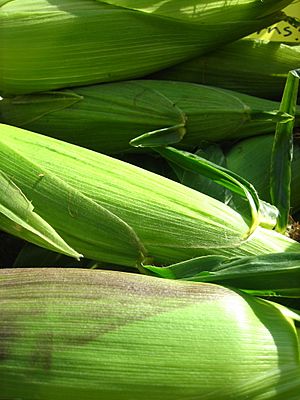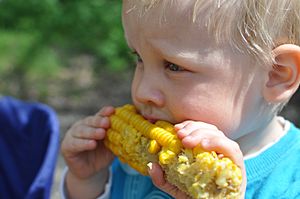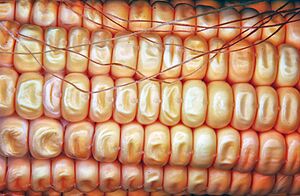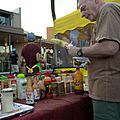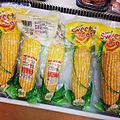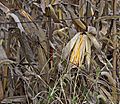Sweet corn facts for kids
Quick facts for kids Sweetcorn |
|
|---|---|
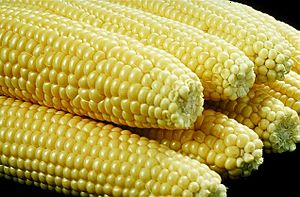
Husked sweet corn
|
|
| Species | Zea mays convar. saccharata var. rugosa |
| Origin | United States |
Sweet corn is a special type of maize (which is also called corn). It has a lot of natural sugar in its kernels, making it taste sweet. People usually eat sweet corn as a vegetable.
Sweet corn is one of the six main kinds of corn. The others include dent corn, flint corn, pod corn, popcorn, and flour corn. Each type of corn has different uses!
Contents
The Story of Sweet Corn
Sweet corn first appeared naturally from regular field corn. Native American tribes were the first to grow it. The Iroquois tribe shared the first recorded sweet corn, which they called 'Papoon', with European settlers in 1779. After that, sweet corn quickly became a popular food in the southern and central parts of the United States.
In the 1800s, different kinds of white sweet corn became widely available. Two types that are still around today are 'Country Gentleman' and 'Stowell's Evergreen'.
In the 1900s, new ways of growing sweet corn made it even better:
- Hybrid Corn: Scientists learned to create hybrid sweet corn. This made the corn grow more evenly, taste better, and resist diseases.
- In 1933, a hybrid called 'Golden Cross Bantam' was created. It was the first successful hybrid made to fight a disease called Stewart's wilt.
- Sweetness Genes: Scientists also found the specific genes that make corn sweet. This helped them create new types of sweet corn with different levels of sweetness. The main genes are called su (normal sugary), se (sugary enhanced), and sh2 (shrunken-2).
Today, there are hundreds of different types of sweet corn, and new ones are always being developed!
How Sweet Corn Grows
The part of the sweet corn plant we eat is the kernel. Many kernels grow together on a cob, which is like the core of the corn ear. The whole ear of corn is covered by tight leaves called the husk.
You might also see fine, silky threads coming out of the top of the husk. These are called silk. Before you eat corn, you need to remove the husk and silk. This process is called husking or shucking.
Did you know that corn always has an even number of rows of kernels? This is because corn is a monocot, a type of plant that grows in a specific way.
Eating Sweet Corn Around the World
Sweet corn is a popular food in many countries!
- In most of Latin America, people often eat sweet corn with beans. This is a smart combination because each plant has important nutrients that the other might be missing. Together, they make a complete and healthy meal!
- In Brazil, sweet corn kernels are often mixed with peas. This mix is added to salads, stews, rice, and even hot dogs.
- In Malaysia, there's a special kind of sweet corn called "pearl corn." Its kernels are shiny and white, like pearls! You can eat them raw or boiled with salt.
- In the Philippines, street vendors sell boiled sweet corn kernels with margarine and cheese powder as a tasty snack.
- In Indonesia, sweet corn is sometimes ground or soaked with milk. This helps your body get a special B vitamin called niacin from the corn. In Brazil, ground sweet corn and milk are used to make dishes like pamonha and a pudding called curau.
Sweet corn kernels are usually boiled or steamed. In Europe and Asia, they are often used as a pizza topping or in salads. Corn on the cob is a whole ear of sweet corn that has been boiled, steamed, or grilled. You can eat the kernels right off the cob or cut them off. Creamed corn is sweet corn served in a milk or cream sauce. You can also eat very young sweet corn, called baby corn.
In the United States, sweet corn is a very popular vegetable. It's often steamed or eaten on the cob with butter and salt. You might find it in Tex-Mex dishes like chili, tacos, and salads. When sweet corn is mixed with lima beans, it's called succotash.
If sweet corn kernels are left to dry, they can be cooked in oil to make corn nuts. These expand to about twice their original size. You can also make a delicious sweet corn soup.
Sweet Corn and Your Health
Cooking sweet corn actually helps increase levels of something called ferulic acid. This acid has properties that can help fight cancer. So, sweet corn is not just tasty, it's good for you too!
Different Kinds of Sweet Corn
Most of the sweet corn you see in stores today are hybrids. These hybrids are usually sweeter and stay sweet for longer after they are picked. Older types of sweet corn, called open-pollinated varieties, are best cooked very soon after they are harvested.
Even though they don't stay sweet as long, many home gardeners still love open-pollinated types like 'Golden Bantam'. People often say these older varieties are more tender and have a richer flavor than the newer hybrids.
Images for kids
See also
 In Spanish: Maíz dulce para niños
In Spanish: Maíz dulce para niños




